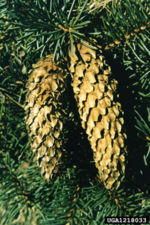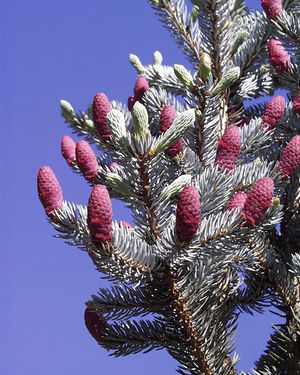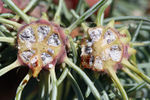Blue spruce
| Blue Spruce |
|---|

|
| Scientific Classification |
The Blue Spruce is a medium to large species of spruce known by the scientific name (Picea Pungens). Other common names for this evergreen tree are Colorado Spruce, Silver Spruce, Colorado Blue Spruce, and Pino Real. It prefers a rich, moist soil and is native to western North America.
Anatomy
Blue Spruce height is 30 to 100 feet, and the trunk usually has a diameter of 1 1/2 to 3 feet. It has a narrow, pyramidal shape and cone-shaped crown. When the tree becomes older, it often takes on a more irregular appearance.
Blue spruce grows relatively slowly, but it is long-lived and may reach the age of 600 to 800 years.
Its leaves (needles) are 1-1 1/2 inches long on the lower branches
and a little shorter on the upper branches. The needles have a very sharp point, which gives the species its name "pungens," from the Latin word for sharp. Needles for the most part are a dull bluish-gray to silvery blue color, but some trees have a more distinct bluish-white or silvery-white foliage. The cultivated variety Picea Glauca or White Spruce is distinguished for this type of coloration.
Blue spruce bark is thin that becomes moderately thick with age. When the tree is young, the bark is small flattened scales and is somewhat a pale-grey color. Then as it matures, the bark turns reddish brown and furrowed.
Blue spruce is fairly shade tolerant and grows best in deep, rich, gravelly soils, often along stream banks and other sites with high moisture levels. The Blue Spruce's deep penetrating root system makes the species resistant to being blown over. It usually does not grow in large groups but is often found in small groves or in association with Douglas-Fir, Lodgepole Pine, Engelmann Spruce or Ponderosa Pine.
Reproduction
Blue Spruce is a monoecious producing tree. It's male flowers are a reddish purple and ripen to yellow-brown, female flowers are purple in color. They both occur on the same tree, although in different locations. Male flowers are scattered, and female in the top of the tree.
Pollination occurs in late spring, and cones mature in the fall when they are 2 to 4 inches long and turn chestnut brown with stiff, flattened scales. The cones cones generally persist on the tree for one to two years after seed fall.
Ecology
Major pathogenic organisms include the Western Spruce Dwarf Mistletoe, Spruce Bark Beetle, and spruce Budworm. Trees infected with mistletoe typically develop abnormal masses of branches called "witches brooms". With severe infestations, trees may die.
Blue spruce has restricted importance to wildlife, but does provide cover and seeds for squirrels, rodents and some birds.
One of the most common human uses of the Blue Spruce is a windbreaker. The tree's crown is very dense therefore offers excellent wind velocity reduction. Blue Spruce is commonly planted in landscapes, but it takes a good garden design plan to make this tree fit in a garden’s color scheme.
Blue Spruce is a popular evergreen tree and at least thousands purchase them at Christmas time. It is a favorite because of its symmetrical form, full foliage and its blue moonlit color.









